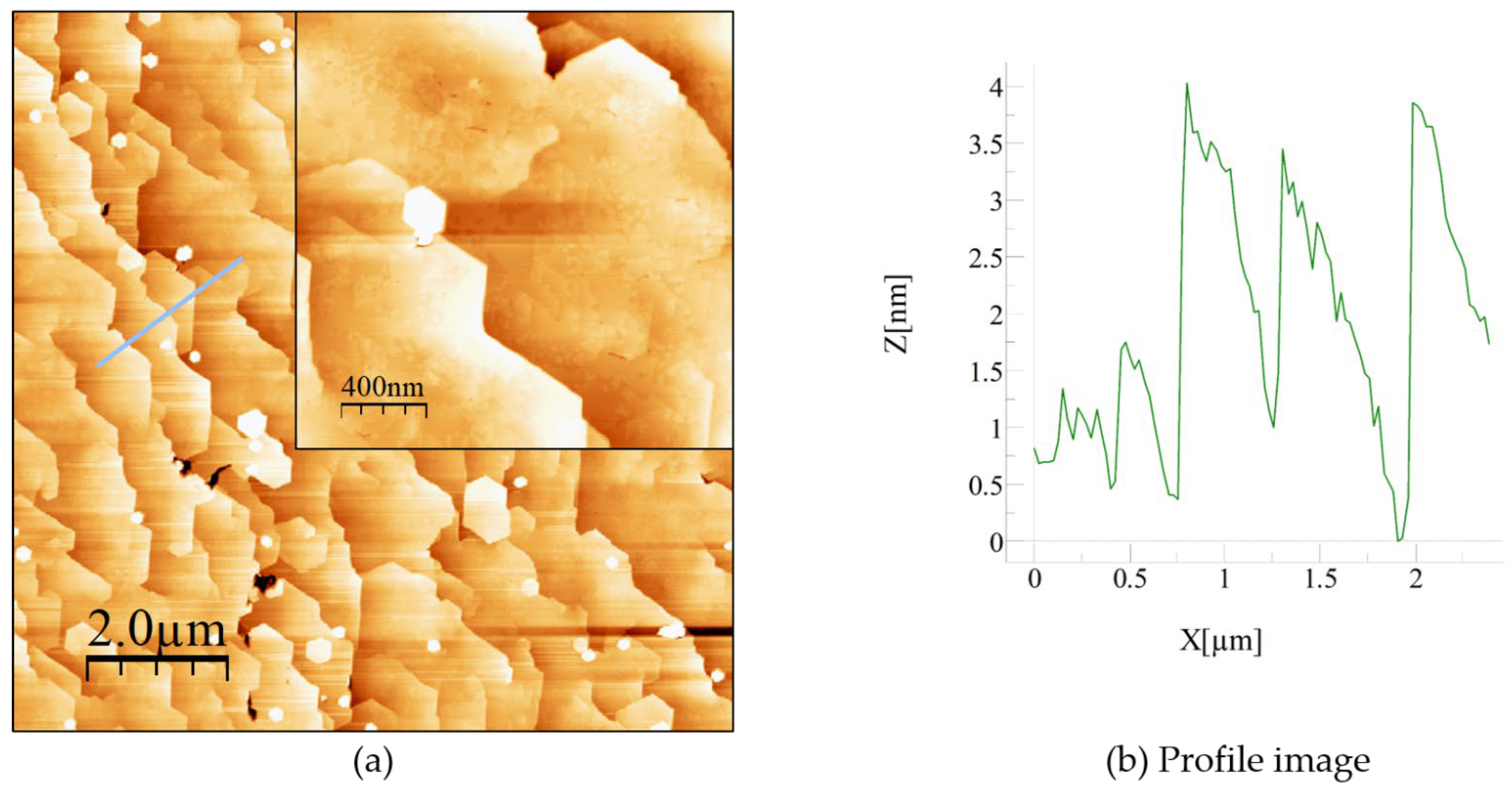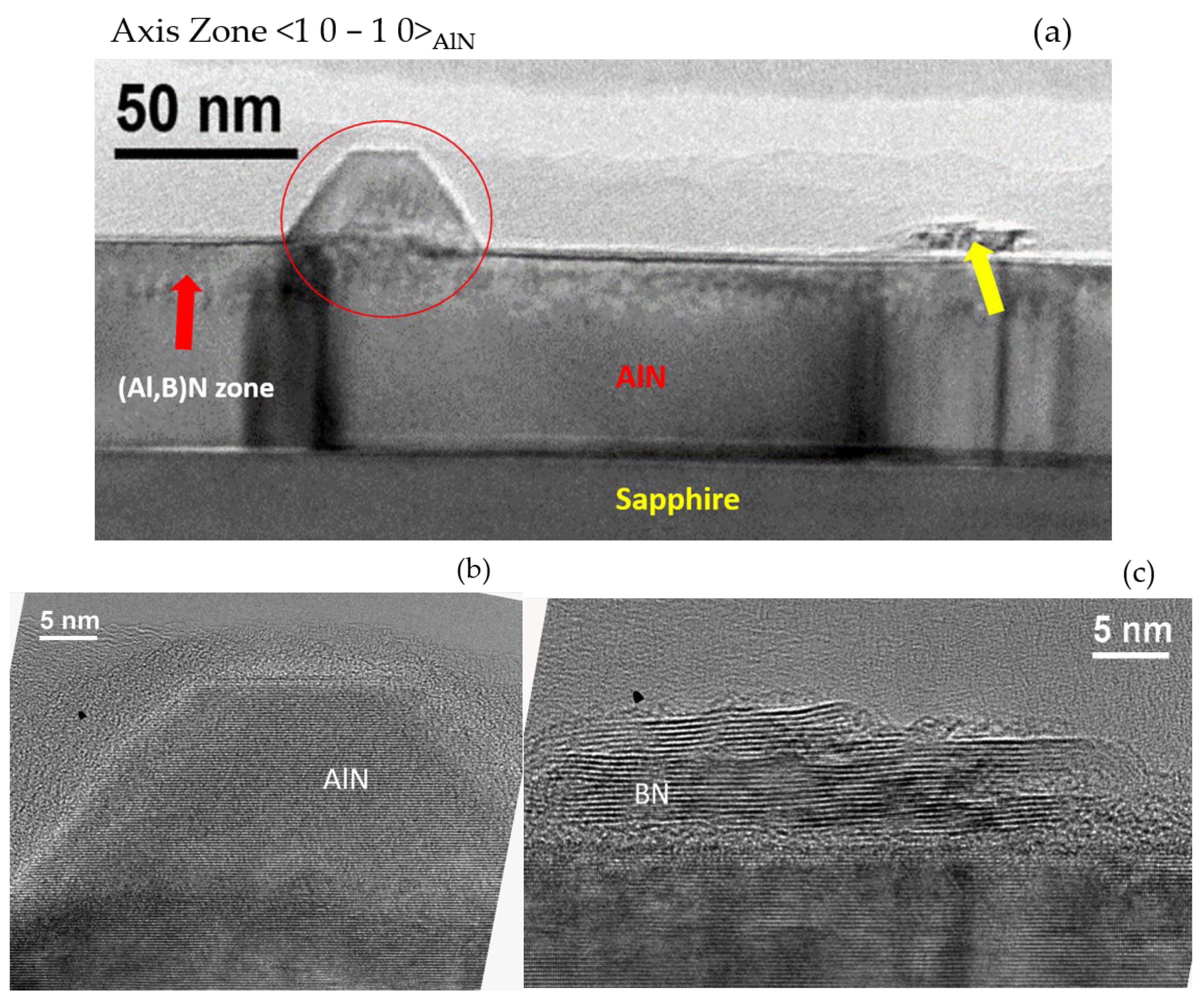Crystalline Quality and Surface Morphology Improvement of Face-to-Face Annealed MBE-Grown AlN on h-BN
Abstract
1. Introduction
2. Materials and Methods
3. Results
3.1. Growth of AlN by MBE
3.1.1. Characterization of h-BN Templates before Growth
3.1.2. Growth of AlN on h-BN/Sapphire Templates by MBE
3.2. Postgrowth High-Temperature Annealing
3.3. AlN Regrowth by MBE
4. Discussion
5. Conclusions
Supplementary Materials
Author Contributions
Funding
Institutional Review Board Statement
Informed Consent Statement
Data Availability Statement
Acknowledgments
Conflicts of Interest
References
- Taniyasu, Y.; Kasu, M.; Makimoto, T. An Aluminium Nitride Light-Emitting Diode with a Wavelength of 210 Nanometres. Nature 2006, 441, 325–328. [Google Scholar] [CrossRef] [PubMed]
- Faleev, N.; Lu, H.; Schaff, W.J. Low Density of Threading Dislocations in AlN Grown on Sapphire. J. Appl. Phys. 2007, 101, 093516. [Google Scholar] [CrossRef]
- Liu, B.; Gao, J.; Wu, K.M.; Liu, C. Preparation and Rapid Thermal Annealing of AlN Thin Films Grown by Molecular Beam Epitaxy. Solid State Commun. 2009, 149, 715–717. [Google Scholar] [CrossRef]
- Khan, A.; Balakrishnan, K.; Katona, T. Ultraviolet Light-Emitting Diodes Based on Group Three Nitrides. Nat. Photonics 2008, 2, 77–84. [Google Scholar] [CrossRef]
- Shur, M.S.; Gaska, R. Deep-Ultraviolet Light-Emitting Diodes. IEEE Trans. Electron Devices 2010, 57, 12–25. [Google Scholar] [CrossRef]
- Nemoz, M.; Dagher, R.; Matta, S.; Michon, A.; Vennéguès, P.; Brault, J. Dislocation Densities Reduction in MBE-Grown AlN Thin Films by High-Temperature Annealing. J. Cryst. Growth 2017, 461, 10–15. [Google Scholar] [CrossRef]
- Miyake, H.; Nishio, G.; Suzuki, S.; Hiramatsu, K.; Fukuyama, H.; Kaur, J.; Kuwano, N. Annealing of an AlN Buffer Layer in N2–CO for Growth of a High-Quality AlN Film on Sapphire. Appl. Phys. Express 2016, 9, 025501. [Google Scholar] [CrossRef]
- Miyake, H.; Lin, C.H.; Tokoro, K.; Hiramatsu, K. Preparation of High-Quality AlN on Sapphire by High-Temperature Face-to-Face Annealing. J. Cryst. Growth 2016, 456, 155–159. [Google Scholar] [CrossRef]
- Koma, A.; Yoshimura, K. Ultrasharp Interfaces Grown with Van Der Waals Epitaxy. Surf. Sci. 1986, 174, 556–560. [Google Scholar] [CrossRef]
- Ajayan, P.; Kim, P.; Banerjee, K. Two-Dimensional van Der Waals Materials. Phys. Today 2016, 69, 38–44. [Google Scholar] [CrossRef]
- Kobayashi, Y.; Kumakura, K.; Akasaka, T.; Makimoto, T. Layered Boron Nitride as a Release Layer for Mechanical Transfer of GaN-Based Devices. Nature 2012, 484, 223–227. [Google Scholar] [CrossRef] [PubMed]
- Wu, Q.; Guo, Y.; Sundaram, S.; Yan, J.; Zhang, L.; Wei, T.; Wei, X.; Wang, J.; Ougazzaden, A.; Li, J. Exfoliation of AlN Film Using Two-Dimensional Multilayer Hexagonal BN for Deep-Ultraviolet Light-Emitting Diodes. Appl. Phys. Express 2019, 12, 015505. [Google Scholar] [CrossRef]
- Chugh, D.; Adhikari, S.; Wong-Leung, J.; Lysevych, M.; Jagadish, C.; Tan, H.H. Improving the Morphology and Crystal Quality of AlN Grown on Two-Dimensional HBN. Cryst. Growth Des. 2020, 20, 1811–1819. [Google Scholar] [CrossRef]
- Wu, Q.; Yan, J.; Zhang, L.; Chen, X.; Wei, T.; Li, Y.; Liu, Z.; Wei, X.; Zhang, Y.; Wang, J.; et al. Growth Mechanism of AlN on Hexagonal BN/Sapphire Substrate by Metal-Organic Chemical Vapor Deposition. CrystEngComm 2017, 19, 5849–5856. [Google Scholar] [CrossRef]
- Li, X.; Sundaram, S.; El Gmili, Y.; Ayari, T.; Puybaret, R.; Patriarche, G.; Voss, P.L.; Salvestrini, J.P.; Ougazzaden, A. Large-Area Two-Dimensional Layered Hexagonal Boron Nitride Grown on Sapphire by Metalorganic Vapor Phase Epitaxy. Cryst. Growth Des. 2016, 16, 3409–3415. [Google Scholar] [CrossRef]
- Horcas, I.; Fernández, R.; Gómez-Rodríguez, J.M.; Colchero, J.; Gómez-Herrero, J.; Baro, A.M. WSXM: A Software for Scanning Probe Microscopy and a Tool for Nanotechnology. Rev. Sci. Instrum. 2007, 78, 013705. [Google Scholar] [CrossRef]
- Saha, S.; Rice, A.; Ghosh, A.; Hasan, S.M.N.; You, W.; Ma, T.; Hunter, A.; Bissell, L.J.; Bedford, R.; Crawford, M.; et al. Comprehensive Characterization and Analysis of Hexagonal Boron Nitride on Sapphire. AIP Adv. 2021, 11, 055008. [Google Scholar] [CrossRef]
- Vuong, P.; Sundaram, S.; Ottapilakkal, V.; Patriarche, G.; Largeau, L.; Srivastava, A.; Mballo, A.; Moudakir, T.; Gautier, S.; Voss, P.L.; et al. Influence of Sapphire Substrate Orientation on the van Der Waals Epitaxy of III-Nitrides on 2D Hexagonal Boron Nitride: Implication for Optoelectronic Devices. ACS Appl. Nano Mater. 2022, 5, 791–800. [Google Scholar] [CrossRef]
- Smith, A.R.; Feenstra, R.M.; Greve, D.W.; Shin, M.S.; Skowronski, M.; Neugebauer, J.; Northrup, J.E. Determination of Wurtzite GaN Lattice Polarity Based on Surface Reconstruction. Appl. Phys. Lett. 1998, 72, 2114–2116. [Google Scholar] [CrossRef][Green Version]
- Xia, Y.; Brault, J.; Vennéguès, P.; Nemoz, M.; Teisseire, M.; Leroux, M.; Chauveau, J.M. Growth of Ga- and N-Polar GaN Layers on O Face ZnO Substrates by Molecular Beam Epitaxy. J. Cryst. Growth 2014, 388, 35–41. [Google Scholar] [CrossRef]
- Lafford, T.A.; Tanner, B.K.; Parbrook, P.J. Direct Measurement of Twist Mosaic in GaN Epitaxial Films as a Function of Growth Temperature. J. Phys. D Appl. Phys. 2003, 36, 245–248. [Google Scholar] [CrossRef]
- Wang, H.; Zhang, H.; Wang, Y.; Tan, W.; Huo, D. Spin Glass Feature and Exchange Bias Effect in Metallic Pt/Antiferromagnetic LaMnO3 Heterostructure. J. Phys. Condens. Matter 2021, 33, 285802. [Google Scholar] [CrossRef] [PubMed]
- Dunn, C.G.; Kogh, E.F. Comparison of Dislocation Densities of Primary and Secondary Recrystallization Grains of Si-Fe. Acta Metall. 1957, 5, 548–554. [Google Scholar] [CrossRef]
- Follstaedt, D.M.; Missert, N.A.; Koleske, D.D.; Mitchell, C.C.; Cross, K.C. Plan-View Image Contrast of Dislocations in GaN. Appl. Phys. Lett. 2003, 83, 4797–4799. [Google Scholar] [CrossRef]
- Kaur, J.; Kuwano, N.; Jamaludin, K.R.; Mitsuhara, M.; Saito, H.; Hata, S.; Suzuki, S.; Miyake, H.; Hiramatsu, K.; Fukuyama, H. Electron Microscopy Analysis of Microstructure of Postannealed Aluminum Nitride Template. Appl. Phys. Express 2016, 9, 065502. [Google Scholar] [CrossRef]
- Hagedorn, S.; Walde, S.; Mogilatenko, A.; Weyers, M.; Cancellara, L.; Albrecht, M.; Jaeger, D. Stabilization of Sputtered AlN/Sapphire Templates during High Temperature Annealing. J. Cryst. Growth 2019, 512, 142–146. [Google Scholar] [CrossRef]











| Annealing Temperature (°C) | RMS (nm) (10 × 10) µm2 | (0 0 0 2) (°) | (1 0 −1 1) (°) | Estimated Mixed TDD (cm−2) | Estimated Edge TDD (cm−2) | |
|---|---|---|---|---|---|---|
| Sample A (AlN 50 nm) | W/O | 5.2 | 0.93 | 5.67 | 4.0 × 1010 | 3.0 × 1012 |
| 1450 | 2.0 | 0.73 | 5.50 | 2.1 × 1010 | 2.2 × 1012 | |
| 1550 1650 1650 | 1.5 2.5 2.1 | 0.54 0.39 0.35 | 4.60 3.77 3.14 | 1.2 × 1010 6.2 × 109 5.0 × 109 | 1.6 × 1012 1.2 × 1012 9.0 × 1011 | |
| Sample B (AlN 100 nm) | W/O 1450 1550 1650 1650 | 5.5 3.7 2.5 4.1 4.3 | 1.10 0.62 0.48 0.35 0.31 | 6.62 5.01 4.22 3.42 3.06 | 5.0 × 1010 1.6 × 1010 1.1 × 1010 5.1 × 109 4.0 × 109 | 4.0 × 1012 2.6 × 1012 1.8 × 1012 1.1 × 1012 8.0 × 1011 |
| Sample C (AlN 220 nm) | - | 1.7 | 0.31 | 2.89 | 4.0 × 109 | 7.0 × 1011 |
Publisher’s Note: MDPI stays neutral with regard to jurisdictional claims in published maps and institutional affiliations. |
© 2022 by the authors. Licensee MDPI, Basel, Switzerland. This article is an open access article distributed under the terms and conditions of the Creative Commons Attribution (CC BY) license (https://creativecommons.org/licenses/by/4.0/).
Share and Cite
Zaiter, A.; Michon, A.; Nemoz, M.; Courville, A.; Vennéguès, P.; Ottapilakkal, V.; Vuong, P.; Sundaram, S.; Ougazzaden, A.; Brault, J. Crystalline Quality and Surface Morphology Improvement of Face-to-Face Annealed MBE-Grown AlN on h-BN. Materials 2022, 15, 8602. https://doi.org/10.3390/ma15238602
Zaiter A, Michon A, Nemoz M, Courville A, Vennéguès P, Ottapilakkal V, Vuong P, Sundaram S, Ougazzaden A, Brault J. Crystalline Quality and Surface Morphology Improvement of Face-to-Face Annealed MBE-Grown AlN on h-BN. Materials. 2022; 15(23):8602. https://doi.org/10.3390/ma15238602
Chicago/Turabian StyleZaiter, Aly, Adrien Michon, Maud Nemoz, Aimeric Courville, Philippe Vennéguès, Vishnu Ottapilakkal, Phuong Vuong, Suresh Sundaram, Abdallah Ougazzaden, and Julien Brault. 2022. "Crystalline Quality and Surface Morphology Improvement of Face-to-Face Annealed MBE-Grown AlN on h-BN" Materials 15, no. 23: 8602. https://doi.org/10.3390/ma15238602
APA StyleZaiter, A., Michon, A., Nemoz, M., Courville, A., Vennéguès, P., Ottapilakkal, V., Vuong, P., Sundaram, S., Ougazzaden, A., & Brault, J. (2022). Crystalline Quality and Surface Morphology Improvement of Face-to-Face Annealed MBE-Grown AlN on h-BN. Materials, 15(23), 8602. https://doi.org/10.3390/ma15238602







